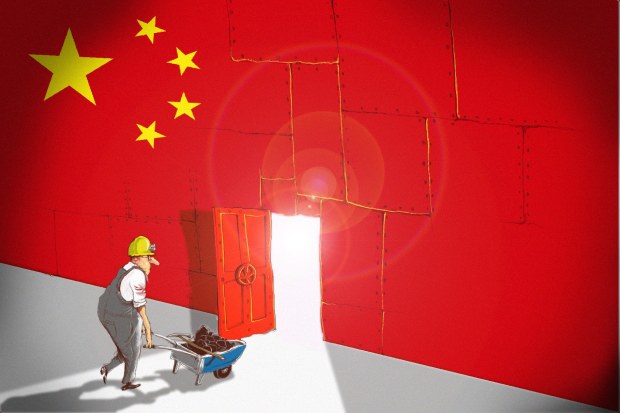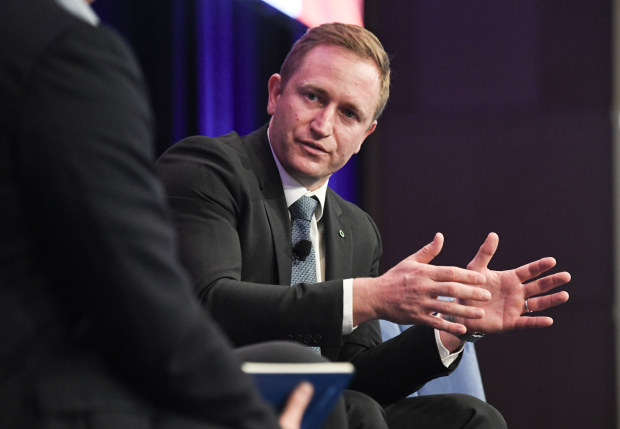The number that should scare all Australians
You couldn’t blame Australia’s large cap fund managers for booking a post-reporting season trip to China to see the steel situation for themselves.
Listen to this article6 minFor everything written about the iron ore price and its dip below $US100 a tonne, one statistic stands out.
Only 1 per cent of Chinese steel mills are currently profitable.
Iron ore shipments to China account for nearly 20 per cent of Australia’s annual exports. This makes the steel mill statistics concerning. David Rowe
One per cent – that’s hard to fathom. Yes, it is not unusual for Chinese steel mills to operate at a loss, but for only 1 per cent to be making money is ridiculously low and unlike anything seen in the past five years.
The 1 per cent statistic comes from a survey by Mysteel, a Chinese reporting agency. The survey also showed these steel mills’ hot metal output had dropped materially – much more than at the same time last year.
Goldman Sachs’ commodities research team picked it up and said iron ore’s “fundamental outlook remains bleak”. They called the past week’s recovery rally – where iron ore bounced off its $US92 ($135) a tonne low to the high $US90s – “unsustainable”.
RELATED QUOTES
BHPBHP Group
$40.610 -0.81%View BHP related articlesAug 23Nov 23Feb 24Aug 2439.00042.00045.00048.00051.000Updated: Aug 25, 2024 – 4.19pm. Data is 20 mins delayed.Advertisement“While both port and in-plant iron ore stocks declined this week, visible stocks remain elevated compared to ‘normal’ August levels,” the broker said. “And mills’ destocking (despite the drop in iron ore prices) could be an indication of a negative production outlook.”
Goldman struggles to see how iron ore can go back above $US100 without a material increase in hot metal production.
Why? Because on the supply side of the ledger, supply is strong – just ask Australia’s big three listed iron ore miners, or Gina Rinehart’s Hancock Prospecting. And iron ore may need to stay below $US100 a tonne for a while to shake out some of the lower-quality miners (not our big four) and lead to any sort of supply-side response.
Compounding the price fall is that Chinese iron ore stocks at ports and mills are near six-year highs – which means they have plenty of stock sitting around even if that supply-side shake-out does arrive.
Some iron ore watchers are calling it the end of the greatest commodity boom this century; one that has been especially good to Australia. They don’t think China has a rabbit to pull out of the hat – something that would spark construction and demand for steel – as it has repeatedly done when required in the past 15 years.
It creates an interesting backdrop for BHP and Fortescue’s full-year results, due on Tuesday and Wednesday.
The last time we heard from Fortescue, chief executive Dino Otranto was phoning into the June quarter production call from China and talking up how hungry customers were for his company’s iron ore, including from its Belinga project in **on, Fortescue’s first outside of Australia.
Fortescue’s Dino Otranto told investors and analysts last month that Chinese customers were supportive of Fortescue’s growth plans. Peter Rae
We expect he’ll still feel pretty bullish, even if data coming out of China is weak. It will be a similar test for BHP’s Mike Henry.
How can Chinese steel mills keep buying so much iron ore when they don’t make money? On the economic front, Goldman’s China property team also cut forecast property starts and completions for 2024, while its China economists think there is rising risk to Chinese growth. You don’t have to be a genius to work out what that would mean for steel demand.
And it is not just Goldman pointing out these weaknesses in China. Bank of America’s August China consumer sentiment survey found only 30 per cent of respondents thought they would spend more in the coming six months, down from 45 per cent in June, while income growth and future income expectations also weakened.
You couldn’t blame Australia’s large cap fund managers for booking a post-reporting season trip to China to see it for themselves. It is a huge concern, particularly for the Pilbara miners – who collectively export more than 1 billion tonnes of iron ore a year to China – and their investors. The Baowu chairman’s “severe winter” proclamation for the steel industry comment lingers.
Of course, the big Australian miners can still make good money with iron ore at less than $US100 a tonne.
At $US95 a tonne, where it was a week ago, UBS analysts said BHP had the strongest margins thanks to its industry-leading cash costs and higher iron content than WA rivals, and would still make more than $US50 a tonne. Brazil’s Vale, Rio Tinto and Fortescue are next best, in terms of the majors.
UBS said Mineral Resources is highest on its value-in-use cost curve, reflecting its higher-cost Pilbara hub production, and early phase ramp-up at the Onslow iron ore project.
UBS says the supply-side response will come – it always does. Iron ore had traded below $US100 a tonne seven times since its peak in May 2021 ($US233 a tonne) and each time the market adjusted by supply exiting. The question is whether it takes a bit longer for the adjustment to help the iron ore price, given port stocks.
Whatever happens in the near-term, analysts and fund managers have called for iron ore to be below $US100 a tonne for years. It is not unexpected.
While it’s a big deal for miners’ profits, it is also material to Australia’s budget given iron ore accounts for nearly one-fifth of Australia’s exports. A $US10 a tonne decrease would shave $5.3 billion off Australia’s nominal GDP this year and $500 million from tax receipts, according to the federal budget papers, making it one of the budget’s biggest swing factors.
That makes it a big deal for the country. If the bears are right, and Australia’s hungry iron ore customer is past its peak, the country will have bigger things to worry about than BHP, Rio and Fortescue’s share prices and dividends.
- Forums
- ASX - By Stock
- AKO General Discussion
The number that should scare all AustraliansYou couldn’t blame...
-
-
- There are more pages in this discussion • 15 more messages in this thread...
You’re viewing a single post only. To view the entire thread just sign in or Join Now (FREE)
Featured News
Add AKO (ASX) to my watchlist
 (20min delay) (20min delay)
|
|||||
|
Last
13.0¢ |
Change
0.000(0.00%) |
Mkt cap ! $15.66M | |||
| Open | High | Low | Value | Volume |
| 0.0¢ | 0.0¢ | 0.0¢ | $0 | 0 |
Buyers (Bids)
| No. | Vol. | Price($) |
|---|---|---|
| 2 | 36227 | 12.5¢ |
Sellers (Offers)
| Price($) | Vol. | No. |
|---|---|---|
| 14.0¢ | 68963 | 1 |
View Market Depth
| No. | Vol. | Price($) |
|---|---|---|
| 2 | 36227 | 0.125 |
| 2 | 43635 | 0.120 |
| 1 | 70000 | 0.115 |
| 1 | 100000 | 0.100 |
| 1 | 100000 | 0.090 |
| Price($) | Vol. | No. |
|---|---|---|
| 0.140 | 68963 | 1 |
| 0.150 | 139800 | 5 |
| 0.155 | 39521 | 2 |
| 0.160 | 63967 | 1 |
| 0.195 | 2653 | 1 |
| Last trade - 16.12pm 01/11/2024 (20 minute delay) ? |
Featured News
| AKO (ASX) Chart |
Day chart unavailable











